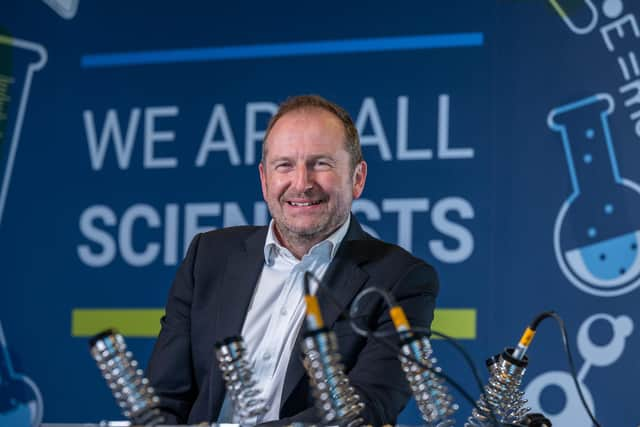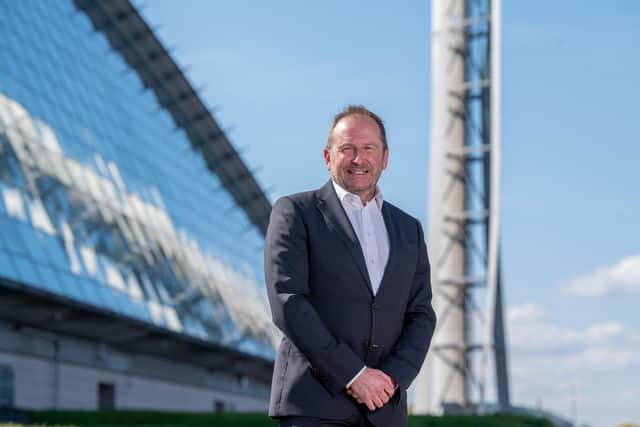The Big Interview: Stephen Breslin, CEO of Glasgow Science Centre
The building, located at Pacific Quay in Scotland’s largest city and a major player in its regeneration, was originally designed to “reflect the scale and drama” of the large ships that had been moored along the quayside of the River Clyde when it was a major industrial waterway.
Since opening it has welcomed 6.5 million visitors, while the pandemic saw it power up its online offering, with 30,000 pupils and 1,000 teachers having since September 2020 taken part in Learning Lab, its remote science, technology, engineering and maths learning programme, for example.
Advertisement
Hide AdAdvertisement
Hide AdLast year it had a key role as a COP26 venue, and earlier this year it was announced as among science hubs in Scotland’s four biggest cities to have teamed up to create the National Climate Campaign, aiming to bring the latest relevant research and knowledge to Scots everywhere.
The CEO, who took the helm in 2012, says he was thrilled to have in 2019 been awarded an honorary doctorate by University of the West of Scotland in recognition of his efforts to raise the profile of science, engineering and technology across society.
He now says: “Even though the award was individual, to me it was a recognition of what we have achieved as a team within the Glasgow Science Centre.
“Raising the profile of science, engineering and technology is crucial, and through the work that we’re doing, we want to help develop skills and create pathways into further employment or study, bridging gaps between industry, academia and government to ensure opportunities are within reach.”
How much of a milestone is Glasgow Science Centre’s 21st anniversary – its director of science has said the team “couldn’t have foreseen just how much the world would change and how much we would also change and adapt” since it launched...


In 2001, the first draft of the human genome was released – it had taken 13 years to sequence. To demonstrate just how far we’ve come, in 2022 it can be sequenced in a matter of hours. 2001 was significant to us for another reason. Back then, the concept of a “science centre” was relatively new, but Glasgow Science Centre became one of the city’s most important institutions.
It was the result of major investment by The Millennium Commission to create flagship science centres across the UK. We were a bit of a novelty, and the focus was on entertainment – “a great family day out”. Since then, our understanding of our role in society has developed.
While it is critical that we provide an enjoyable experience, we are driven by a deep sense of purpose, which is to help people from all backgrounds and of all ages to develop to their fullest potential.


Advertisement
Hide AdAdvertisement
Hide AdAdvances in technology have created some incredible opportunities and we want to excite people about these, building their confidence and skills so they can access them – especially those who, for whatever reason, don’t feel like science is for them.
To what extent has the pandemic given the Centre’s work a more key and prominent role?
When a visitor attraction must close its doors to visitors it really forces you to re-think your entire value proposition and re-invent yourself. We took the decision to go online immediately and broadcast our first live science show the day after we closed our doors, creating original content every day for the first lockdown. We were overwhelmed by the response, and reached well over 1 million views globally.
We went on to create our digital schools programme, which, two years on, is going from strength to strength and being delivered across Scotland.
Pre-pandemic, a young person might visit us once a year. We believe that interest and confidence builds over time from extended engagement and our digital programmes have given us the opportunity to do that.
Glasgow Science Centre had a pivotal role in COP26 – you’ve called the event the busiest fortnight in its history – but the venue also came under scrutiny over its own carbon footprint. What are your thoughts on these issues? You’ve been working with Zero Waste Scotland, for example…
As one of the key venues for COP26, we needed to make sure that our own credentials stood up to scrutiny. Like most businesses, we are on a path to net zero, and we have a plan, but it will take constant attention to get there.
We have looked at every part of our business to see how we can become more sustainable, from how we source and prepare our food for our catering and corporate events to making our buildings more energy-efficient and examining our own resource-consumption. We have redesigned our outside spaces to encourage active travel and rewilded much of our green areas, for example.
Advertisement
Hide AdAdvertisement
Hide AdThe Centre was one of the funders of the CAN DO Innovation Summit this year – to what extent can your team help catalyse innovation/entrepreneurship in Scotland?
Our strategy can be summarised as inspiring futures, building connection, and developing understanding. That means inspiring young people through exciting examples of innovation happening on our doorstep, connecting them with scientists and engineers, supporting them on pathways into these careers, and to help them understand what it is to be an innovator or a scientist.
There is so much to get excited about in Scotland at the moment including space technology, precision medicine, quantum technologies, photonics and advanced manufacturing. One of our roles is to showcase the very best of innovation in these industries, bridging a gap between academia, industry, business and the rest of Scotland. We want to use that to fuel ambition, not just in young people, but in society as a whole.
In terms of your time before joining the Centre, you say you have been excited by science and technology from as early as you can remember, and went on to study engineering, for example. Can you detail your path to your current role?
I have always been a bit of an aviation geek, and have always wanted to understand how machines work. I decided pretty early on, once I had given up on my dreams of being a pilot because of my eyesight, that I wanted to study mechanical engineering at the University of Strathclyde, where I was sponsored by the Ford Motor Company.
I then went on to complete an MSc in control systems engineering at the University of Sheffield before coming home to join what is now BAE Systems as an engineering consultant and I was mostly seconded to the Royal Navy at the Clyde Submarine Base. For a young man, it was a dream job. I also managed to go to sea a couple of times on submarines, something I will never forget.
After that I went back to Strathclyde to do a PhD in control systems design for fighter aircraft sponsored by BAE Systems, before becoming a professional software engineer.
Six years later, I was offered the position of chief technology officer for a publicly funded start-up called The Kelvin Institute, a collaboration between the Universities of Strathclyde and Glasgow and Scottish Enterprise. We worked with academics to help them commercialise their technology and a year later I took over the role of CEO.
Advertisement
Hide AdAdvertisement
Hide AdThe next move took me to London as CEO of a charity called Futurelab Education and this opened my eyes to the responsibility that we all have to develop our young people.
When the opportunity at Glasgow Science Centre came up, I saw the chance to bring together my lifelong love of science and technology with this newfound appreciation of the responsibilities that we have to our young people. Ten years in and I have never been happier in my career. It is, without doubt, the best job I have ever had.
Glasgow Science Centre is working on its strategic plan to 2025 – how is this progressing, and ideally what will it be achieving by then?
While we’re very much focused on young people and developing opportunities for them, we want to add value to all parts of society, engaging with people of all ages and from varying walks of life.
Our vision is to create a Scotland where all people feel empowered through learning and engagement with science to make positive differences in their lives, their communities, and to society as a whole.
Our adaptation to the challenges of lockdown has created significant opportunities that have allowed us to extend our reach, influence, and delivery of our mission – and through our strategic plan, we are ensuring that these projects are sustainable for the future as we look to achieve our 2025 vision.
Comments
Want to join the conversation? Please or to comment on this article.
